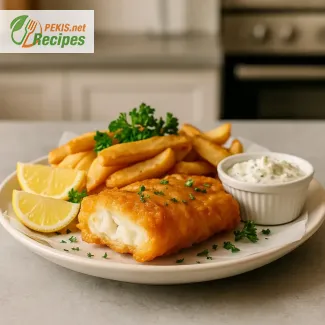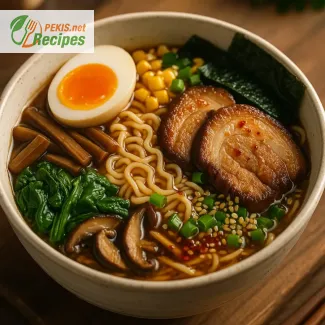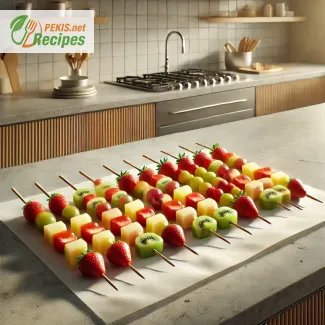
The Ultimate Guide to Traditional British Fish and Chips
Discover the authentic taste of Britain's most beloved comfort food
Nothing captures the essence of British culinary tradition quite like a generous serving of classic fish and chips. Crispy on the outside, flaky on the inside, and always paired with golden fries and a splash of malt vinegar, this iconic dish has been cherished for generations across the UK and beyond. Whether served at a seaside shack wrapped in paper or prepared fresh at home, fish and chips evoke a feeling of comfort, nostalgia, and pure satisfaction. In this easy-to-follow version, you'll uncover the secret to making them at home without the hassle, yet with all the flavor and texture of the original.
The charm of fish and chips lies in its simplicity. A well-executed batter-fried white fish, often cod or haddock, is the hero of the plate, complemented by hand-cut chunky chips—not to be confused with thin fries. The combination of textures and tastes, from the light crunch of the batter to the soft, fluffy interior of the chips, makes this dish a timeless favorite for all age groups.
The cultural legacy of fish and chips in the UK
Historically, fish and chips were more than just a meal—they were a symbol of resilience during hard times. First popularized in the mid-19th century, this dish quickly became a staple of the working-class diet, offering a satisfying and affordable way to feed families. The rise of “chippies” (fish and chip shops) in almost every British town further cemented its status as a national treasure. Even today, no visit to the UK is complete without sampling a traditional serving of fish and chips, ideally with mushy peas, pickled onions, or tartar sauce on the side.
Choosing the right ingredients for authentic flavor
A great fish and chips recipe starts with the right type of fish. Cod is a popular choice due to its mild flavor and firm texture, but haddock, pollock, or plaice also work beautifully. The fish must be fresh, boneless, and evenly cut to ensure it cooks uniformly and retains its moisture under the crispy coating.
Equally important are the chips. Unlike shoestring or fast-food fries, true British chips are thick-cut and double-fried for that perfect contrast of crisp and soft. Made from starchy potatoes like Maris Piper or King Edward, they absorb less oil and achieve a golden crunch with a fluffy center.
Crafting the perfect batter at home
One of the secrets to mastering homemade fish and chips is the batter. A traditional British batter should be light and airy, yet robust enough to form a golden crust that seals in the fish’s natural juices. Achieving this texture typically involves a combination of flour, baking powder, and cold sparkling water or beer, whisked to a smooth consistency. The carbonation creates a lightness in the batter, while a dash of vinegar can help enhance the crispiness.
When fried at the right temperature, the batter turns into a delicate shell that holds the fish without becoming greasy or heavy. For added depth of flavor, many home cooks like to incorporate a touch of seasoning—paprika, cayenne, or garlic powder—though traditionalists often prefer to keep it simple to let the freshness of the fish shine.
Tips for frying fish and chips at home
To ensure the best texture and flavor, the oil temperature should be kept between 175°C to 190°C (347°F to 374°F). Too low, and the batter absorbs excess oil and becomes soggy; too high, and the outside may burn before the fish is fully cooked. Use a deep fryer or a heavy-duty pan filled with a neutral oil such as sunflower or vegetable oil for even heat distribution.
A key technique is to fry in small batches, preventing the oil temperature from dropping too drastically. Start with the chips—they take longer and benefit from double frying: once to cook through, and again for color and crunch. The fish should be fried just before serving to preserve its texture and warmth.
Serving suggestions for the full experience
No fish and chips experience is complete without the traditional accompaniments. Serve with a generous sprinkle of sea salt, a dash of malt vinegar, and a side of homemade tartar sauce or classic mushy peas. For a more elevated twist, consider adding lemon wedges, pickled gherkins, or a sprinkle of fresh parsley to brighten up the plate.
Many fans enjoy this meal with a cold lager or a light ale, enhancing the richness of the batter while refreshing the palate. And of course, don’t forget the presentation—a sheet of greaseproof paper or newspaper lining brings a nostalgic touch to your British-inspired dinner.
A dish rooted in history and flavor
More than just a meal, classic British fish and chips represent a piece of history, a culinary tradition that continues to bring comfort and joy. With the right ingredients, simple techniques, and a bit of care, you can recreate this time-honored dish in your own kitchen, bringing a taste of Britain to your family table. This easy homemade version offers all the crispy satisfaction of the original, with none of the fuss.
Step 1 – Prepare the chips:
Peel the potatoes and cut them into thick chips, approximately 1.5 cm (½ inch) wide. Rinse them under cold water to remove excess starch, then soak in cold water for 10–15 minutes.
Step 2 – Prepare the batter:
In a large bowl, combine all-purpose flour, baking powder, paprika, and salt. Gradually whisk in cold sparkling water and vinegar until the batter is smooth and slightly thick. Let it rest in the fridge for 10 minutes while you heat the oil.
Step 3 – First fry for the chips:
Drain the potatoes and dry them thoroughly with a clean kitchen towel. Heat the sunflower oil to 160°C (320°F) in a deep pan or fryer. Fry the chips in batches for 5–6 minutes until soft but not colored. Remove with a slotted spoon and let them cool on paper towels.
Step 4 – Fry the fish:
Raise the oil temperature to 180°C (356°F). Pat the cod fillets dry with paper towels. Dust each piece lightly with flour, then dip into the batter until fully coated. Lower gently into the hot oil. Fry for 5–7 minutes until the batter is crisp and golden brown. Remove and drain on paper towels.
Step 5 – Second fry for the chips:
Return the par-cooked chips to the oil and fry again at 180°C (356°F) for 3–4 minutes until golden and crispy. Drain on paper towels and sprinkle with salt.
Step 6 – Assemble and serve:
Arrange a portion of chips on each plate with one fillet of battered cod. Add lemon wedges and garnish with fresh parsley. Serve with malt vinegar and tartar sauce on the side if desired.
Elevating Your Homemade Fish and Chips to the Next Level
Smart tips and ingredient swaps to perfect this British classic
Preparing fish and chips at home offers the unique advantage of tailoring the dish to your exact preferences while avoiding the pitfalls of mass-prepared versions. Whether you're aiming to enhance the crispiness of the batter, lighten the overall meal, or infuse your dish with new flavors, there are countless ways to refine and personalize this timeless recipe.
Choosing superior ingredients for better taste
Start with fresh, sustainably sourced white fish—ideally cod, haddock, or pollock. Fresh fillets yield a much more delicate and succulent interior compared to frozen options, which often release excess water during frying. When possible, opt for wild-caught varieties, which tend to have firmer texture and richer taste.
For the chips, using starchy potatoes like Maris Piper or King Edward is essential. These varieties create the ideal contrast between a crispy outside and a soft, fluffy core. You can also enhance the final result by soaking the potato slices in vinegar water for 20 minutes before frying—this reduces sugar content and prevents them from browning too quickly, resulting in a cleaner golden color.
Enhancing the batter for more crunch and flavor
The batter is a critical component that determines texture and visual appeal. To elevate it:
- Replace part of the sparkling water with cold beer, especially lagers or pale ales. This not only increases lightness and aeration, but it also imparts a malty depth of flavor.
- Incorporate a small amount of cornstarch or rice flour (about 10–20% of the total flour) for added crispiness and lighter structure.
- Season the batter directly with smoked paprika, garlic powder, black pepper, or even a hint of mustard powder for nuanced flavor without overpowering the fish.
Always keep the batter cold, and never overmix—it should be silky and light to ensure proper puffing during frying.
Upgrading the chips with modern techniques
While traditional chips are double-fried, you can modernize the process using a parboil + air-fry technique for a lighter version. After cutting and rinsing the potatoes, briefly boil them for 5 minutes, then air-dry and coat lightly with oil before air-frying. This method cuts down on oil absorption while delivering a similar crisp exterior and soft interior.
For extra crunch, sprinkle semolina or polenta on the potatoes before the final fry or air-fry cycle. This tiny addition enhances texture dramatically.
Why homemade fish and chips are superior
Cooking this dish yourself means full control over the quality and healthiness of the meal. You can choose non-GMO oils, avoid excessive salt, and reduce frying time by using better heat monitoring. Homemade also means fresher garnishes like chopped herbs, high-quality homemade tartar sauce, and naturally fermented vinegar—all of which improve both flavor and nutritional value.
Moreover, frying in smaller batches prevents temperature drops in the oil, a common mistake in commercial kitchens. This ensures every piece of fish or chip is golden, crisp, and non-greasy.
Common mistakes to avoid
- Overcrowding the fryer: Reduces oil temperature and causes soggy batter or greasy chips.
- Using warm batter: A room-temperature batter won't puff and crisp correctly.
- Skipping the resting time for batter: Ten minutes of rest helps integrate bubbles and texture evenly.
- Not drying fish or chips adequately before frying: Moisture causes oil splatter and uneven cooking.
Avoid these pitfalls and you'll consistently enjoy restaurant-quality results in your own kitchen.
Healthy and alternative options
If you're aiming for a healthier version, consider the following tweaks:
- Swap cod with tilapia or even tofu for a lower-fat or vegetarian option.
- Instead of deep-frying, oven-bake or air-fry both the fish and chips using a light spray of oil.
- Use whole grain flour or chickpea flour in the batter for added fiber and a nutty flavor twist.
- Serve with steamed greens or salad instead of mushy peas to balance the dish with freshness and nutrients.
You can also replace tartar sauce with a yogurt-based dill dip, which offers the same tangy creaminess with reduced calories and added probiotics.
Adding creative flair without losing tradition
For a modern touch, serve the dish with pickled red onions, spiced aioli, or even a curry dipping sauce, often popular in Northern England. These additions introduce variety while maintaining the comfort food essence of the original.
Adding lemon zest to the batter or a drizzle of herbed vinegar can transform the dish into a more elevated version while keeping its traditional roots intact. The key is to respect the core elements—crispy batter, flaky fish, and hearty chips—while exploring subtle ways to make the dish your own.
Allergens present in the recipe:
- Gluten (wheat flour)
- Fish (cod)
- Egg (possible in tartar sauce, if included)
Tips to avoid allergens and gluten:
- Use gluten-free all-purpose flour to eliminate gluten.
- Replace cod with a plant-based alternative (e.g., banana blossom) for a fish-free version.
- Choose a vegan tartar sauce without egg or dairy components.
Vitamins and minerals per serving (approximate):
- Vitamin B12: 2.5 µg – supports nerve function and red blood cell formation
- Vitamin C: 18 mg – aids in immune defense and collagen synthesis
- Potassium: 1100 mg – helps regulate fluid balance and nerve signals
- Phosphorus: 300 mg – essential for bone health
- Iron: 2.4 mg – supports oxygen transport in the blood
- Magnesium: 45 mg – involved in over 300 enzymatic reactions
- Calcium: 55 mg – contributes to normal bone and muscle function
- Zinc: 1.2 mg – supports immune function and skin health
Antioxidants per serving (approximate):
- Selenium: 36 µg – protects cells from oxidative stress
- Vitamin E: 2.5 mg – neutralizes free radicals and supports skin
- Lutein + Zeaxanthin: 90 µg – supports eye health and vision maintenance





